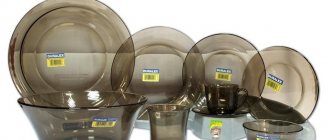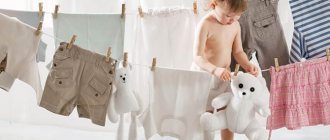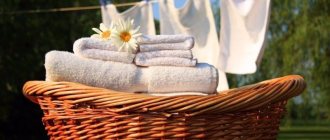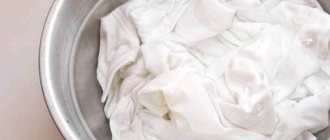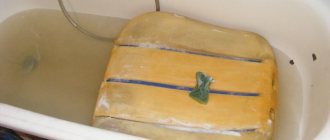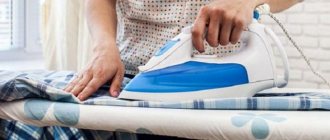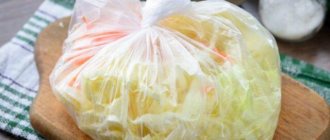Different ways to boil colored and white things.
Every housewife knows, no matter how carefully things are washed, over time they inevitably lose their whiteness and bright color. And the point here is not that a person sets the wrong washing mode or uses a bad powder. No matter how sad it is to admit it, after the most thorough washing, a small amount of dust and dirt always remains in the fibers of fabrics.
That is why periodically all your favorite things should be boiled in special solutions. This simple procedure will help rid clothes, bed linen and towels of everything that has accumulated in the fabric fibers, return them to freshness and, most importantly, disinfect them. You will learn how to boil laundry correctly from our article.
Boiling white laundry to bleach and remove stains: methods, rules, tips
Boiling white clothes
If you like to wear white clothes, then you probably know how difficult it is to wash various stains from them. As a rule, in order for an item to become snow-white again, it has to be washed a couple of times. But still, if you try to boil white linen, you will see that you can achieve the same effect in less time.
As for the methods of boiling such things, in this case it is best to use ready-made bleaching agents, or add bleach and ordinary soda to the water.
So:
- White items can only be boiled in enamel or stainless steel pans. If you use, for example, aluminum containers for these purposes, then during the heat treatment they will oxidize and your items will have a dark tint.
- If there are pronounced stains on the laundry, it is best to wash them first using laundry soap, and only then proceed directly to boiling.
- Also remember not to have too many things in the pan while boiling. If you add more than necessary, the laundry will cook unevenly and as a result, yellow stains will remain on white things. For this reason, it will be better if you add a maximum of 1.5 kg of laundry per 10 liters of water.
How to enhance the effect after boiling
After things have acquired the desired snow-white shade, you want to preserve it for as long as possible, making the products brighter. For this purpose, you can use the following suggestions:
- Rinse clothes in a solution of 9% vinegar. This product helps set the color.
- Blue. This old “grandmother’s” method is best used on white bed linen if you want to get a characteristic cool bluish tint. It is important not to “overdo” adding blue when rinsing, otherwise the products will appear dull and grayish.
- Optical brighteners. These substances are not absorbed into the fibers, but reflect the light falling on them, visually making the washed items snow-white.
- Dry in direct sunlight. This ancient method was practiced for centuries before the invention of chemicals.
To avoid having to spend a lot of time and effort on boiling fabrics, this procedure should be carried out immediately when stains and yellowing are detected.
Boiling colored laundry for bleaching and stain removal: methods, rules, tips
Boiling colored laundry
If we talk about boiling colored laundry, then in this case you can use any soap and disinfectant bases, of course, without the bleaching effect. For this reason, it is strictly forbidden to use bleach, bleach or ready-made bleaching compounds to boil such things.
In this case, the most preferable method would be the simplest boiling method, which uses a soap solution. You can also use salt, washing powder, dish detergent and soda to disinfect and remove stains from brightly colored clothing.
Tips for boiling colored laundry:
- Before sending things to boil, be sure to sort them. In general, try to put laundry of the same color in the pan. In this case, even if some item fades, it will not affect the rest of the clothes.
- Remember that only one portion of laundry can be boiled in one solution. Even if it seems to you that the liquid in the container is not very dirty, drain it and prepare a new portion of the product. If you put things in an already used liquid, you will not be able to get rid of excess dirt and will definitely not renew the color.
- Also, do not forget that colored items must be stirred during the boiling process, using wooden tongs. This must be done so that in the end the item has a uniform color.
Why is boiling necessary?
Processing fabrics at high temperatures removes stubborn stains, deeply ingrained dirt, and restores the lost whiteness to dull and washed-out items. This process is carried out not only for bleaching, but also for disinfection, since hot water paired with detergents can kill most existing pathogens. Using this simple and affordable method, you can destroy bacteria, some viruses, fungus and mold, whiten stains of dirt, urine, feces, blood, saliva, traces of food and drinks. Temperature exposure also destroys allergens.
Boiling white and colored linen for disinfection: methods, rules, tips
Boiling white and colored linen for disinfection
I would like to say right away that boiling in itself is a method of disinfection, so if you boil the linen in a simple soap solution, you can get rid of bacteria and dust mites. However, you must remember that in order for things to be disinfected, they must be in boiling water for at least an hour. This time will be enough for the high temperature to kill the bacteria of such dangerous diseases as tuberculosis, hepatitis and absolutely all childhood diseases.
You can disinfect things in the following ways. If it is white laundry, then use bleach or a mixture of baking soda and lemon juice. If you want to tidy up colored things, then give preference to boric acid or the same laundry soap and soda.
Tips for disinfecting linen:
- Before sending items for disinfection, be sure to shake them as well as possible. By removing all excess dust, you will speed up the cleaning process.
- Remember that delicate items must be disinfected by boiling very carefully. Since they can be boiled for no more than 30 minutes, initially you will need to keep such laundry in a cold disinfectant solution, and then boil it.
- If you used bleach or chlorine to disinfect, then be sure to rinse the item at least three times after heat treatment. Better yet, put it in an automatic washing machine and rinse it mechanically.
Washing different types of clothes
There is no universal detergent for washing everything. Especially when it comes to boiling. In addition, it is worth taking into account the facts of color shedding, the facts of differences between adult and children's clothing, and pay attention to the type of fabric.
Baby clothes
Things of a baby, especially a newborn, need special care and attention to washing. We choose the recipe that is as hypoallergenic as possible, without any strong odors, and replace the laundry soap, as well as the powder, with baby soap.
Children's clothes should be washed carefully.
Tulle
Wash in hot water is suitable for tulle that is made of cotton. Avoid the recipe with washing powder and choose soap shavings. This is due to the fact that the tulle is made of thin fabric, which requires careful care.
The tulle is boiled carefully.
Bed sheets
The boiling method for bleaching and disinfection is used in this case most often. The result will be visible as quickly as possible if the bed is white. The recipe used here is the same as in white and colored clothes made of cotton or linen - gentle.
White bed linen needs to be boiled.
White clothes
If the items have natural fabric, the result will not take long to arrive. Choose a recipe with bleach. If the composition contains synthetics, yellowness may appear.
The boiling process is complex but effective.
Colored clothes
The rules for boiling are the same as the rules for washing. With increased frequency, and especially boiling, colored things lose their color and become more faded. Therefore, the method should not be used often.
It is important to remember not to mix colored clothes with white and not to resort to using bleach.
Underwear
We do not boil synthetics; we carefully wash the lace by hand in warm water, never in boiling water. When underwear is made from natural fabrics, then you can boil it with the recipe: washing powder (half a glass) and soda (5 spoons) per five liters of water.
What is the best way to boil laundry to whiten and remove stains and disinfect?
Products for boiling laundry
Although you can now find a huge amount of bleaching products in stores, it is not always possible to use them for boiling. For example, they are absolutely not suitable for disinfecting delicate and thin-structured fabrics. They will, of course, refresh and whiten the item, but they will damage the fibers of the fabric so much that after drying it will not be deformed.
In view of this, if you do not want to take risks, then boil your laundry with simple and understandable ingredients that our mothers and grandmothers used. It’s true that in this case, you definitely need to take into account the white or colored things you will be boiling. If you plan to tidy up white things, then you can safely add acetylsalicylic acid, bleach, lemon juice, baking soda or hydrogen peroxide to the water.
If you are tidying up colored items, then you can use absolutely all detergents (laundry soap, washing powder, dishwashing detergent), mustard powder, salt, ammonia or boric acid.
How many minutes should you boil laundry to whiten and disinfect?
You need to boil the laundry for at least an hour.
There is an opinion that the longer you boil the laundry, the better the result you can get. In fact, this opinion is wrong. Moreover, if you keep the item in boiling water, even the densest fabric will begin to deform. In view of this, it will be better if you boil the laundry taking into account its color scheme and the density of the material.
So, if you are cleaning things that have been boiled more than once, then you can boil them for 120 minutes. If you bleach and disinfect white linen, you will need to keep it on the stove for no more than 60 minutes. As for clothes made of delicate materials, they should be boiled for no more than 30 minutes.
At first glance, it may seem that this time will not be enough for the thing to become ideal again. But we must not forget that after the above time has elapsed, you will turn off the stove and leave the clothes in the soapy solution until almost completely cooled. And while it remains in the liquid, the process of its cleaning and disinfection will continue.
Features and benefits of digestion
Technological progress is developing rapidly, supermarket shelves are bursting with all kinds of powders and conditioners. But bleaching agents do not always cope with their task: after each wash, particles of dirt and dust still remain on the fabric. And in a standard automatic machine, the maximum washing temperature does not exceed 95°C. All that remains is to resort to a long-known method: decide to boil the laundry so that the gray becomes white.
This process is not complicated, but it is lengthy. You need to understand how to properly boil laundry for bleaching and know the obvious advantages of this procedure. Boiling has five undoubted advantages.
- Disinfection. For infectious diseases (scabies, lice), doctors strongly recommend steaming the patient’s bed linen to avoid re-infection.
- Bleaching. Boiling returns the original whiteness to things and removes gray plaque.
- Removing old stains. After boiling the clothes, stubborn stains disappear without a trace.
- Natural composition. In case of intolerance to chemical elements and skin sensitivity, boiling and washing without harm to health.
- Processing of children's clothing. High temperature helps remove grease stains, traces of paints and felt-tip pens from textiles. Thorough disinfection is also necessary for baby's undershirts and diapers in order to protect the fragile child's body from infections.
The boiling time depends on the degree of soiling of the clothes. On average, you can boil things from half an hour to two hours. After completing the procedure, leave the container on the stove until the solution has cooled.
Boiling laundry with vegetable oil: recipe
Boiling laundry with vegetable oil
No matter how strange it may sound, vegetable oil fights dirt very well and removes the yellowness and grayness of white things. If you mix it with powder or laundry soap, you will get a product for boiling down colored laundry. If you add soda and vinegar to the oil, you can tidy up absolutely all white things.
However, remember that in this case you must strictly adhere to certain rules. First, remember that you can add vegetable oil to water only after the remaining components are completely dissolved in it. If you first pour it into a pan of water, a film will eventually appear on the liquid, which will prevent the powder or soda from dissolving, and as a result, the product will be ineffective.
Secondly, remember that you need to put things in such a solution completely dry. As practice shows, excess liquid makes it difficult for dirt to come off and, most importantly, the color is poorly refreshed.
Recipe for boiling white things
- Pour 10 liters of water into an enamel pan
- Boil it, and then pour 4 tbsp into it. l soda and pour in 100 ml vinegar
- Mix everything thoroughly and wait for the soda to quench
- Add 3 tbsp to the resulting product. l vegetable oil and you can start boiling
Recipe for boiling colored things
- Heat 10 liters of water in a large container and dissolve a bar of laundry soap in it
- When this happens, add 4 tbsp to the soap solution. l vegetable oil and mix everything thoroughly
- As soon as the liquid becomes completely homogeneous, you can put laundry in it
Traditional brewing procedure
Before using such a simple and well-known method, of course, you should learn about the sequence of boiling stages. All of them must be fully implemented. In this case, you can count on receiving a guaranteed result.
Boiling laundry in the usual way begins with dissolving the selected detergent in a prepared vessel filled with water. If you use laundry soap, you must first prepare it - grate it. After this, textiles should be immersed in the warm solution. It is important that they are completely hidden in the water.
When the solution in which the things are located boils, the fire must be reduced slightly. If you neglect this recommendation, you may encounter a problem such as its flowing through the pan. If this happens, the burner on the stove will be flooded with cleaning solution.
When boiling laundry, periodic stirring is necessary. This is required to ensure that each side is well boiled.
There are no strict rules regarding how long boiling should last. The container should be on the stove for 30-120 minutes. The duration of boiling the laundry largely depends on the composition of the solution and how dirty the items are. When the fire is turned off, you need to leave the vessel on the stove so that things cool down a little.
After this, you should thoroughly wring out the boiled laundry, and then rinse it twice in clean water.
Then you should start drying. To do this, things are hung on the street. It is best to do this when the weather is sunny. In this case, textiles and other boiled items will acquire incredible freshness.
It should be noted that the procedure for boiling laundry appeared long before the invention of washing machines and the beginning of the production of powders and various bleaches. However, despite this, after such a procedure, the laundry takes on a better appearance than after washing in an automatic machine.
Boiling laundry with hydrogen peroxide: recipe
Boiling laundry with hydrogen peroxide
If you've ever read the ingredients in a commercial whitening and stain remover product, you probably know that it contains hydrogen peroxide. In view of this, if you wish, you can make a similar product based on it, the effectiveness of which will be no worse than that of a store-bought one.
The only thing you have to remember is that the liquid you get after mixing will absolutely not be suitable for boiling colored things. Since hydrogen peroxide can lighten, you will simply ruin clothes in dark shades with this product.
Recipe for boiling laundry with hydrogen peroxide:
- Fill a large saucepan with 8 liters of water and heat it to 70 degrees
- Add 100 g of powder to it and dissolve it as thoroughly as possible
- At the next stage, add 6 tbsp. l hydrogen peroxide, and mix everything again
Recipe for boiling washed clothes
- To prepare the product you will need water, baking soda and hydrogen peroxide.
- So, take 8 liters of water and add 100 g of soda to it
- When it dissolves, add 5 tbsp to the soda solution. l peroxide
- Bring the liquid to a boil and you can put things in it
Soda or hydroperite
When boiling for bleaching, you can use soda or tableted hydroperite:
- Pour water into a large saucepan.
- For 5-6 kg of laundry, dissolve 10-15 hydroperite tablets in water.
- Add soap shavings to the solution: grate the soap on a coarse grater or cut it into small bars with a knife.
- Load the laundry and place the pan over low heat. The laundry should not be packed too tightly, as this will cause it to cook unevenly.
- Bring to a boil, reduce heat as much as possible.
- Boil the laundry for 1-1.5 hours, stirring occasionally.
- After boiling, leave the laundry in the pan until it cools.
- Rinse the cooled laundry thoroughly in running water and hang to dry.
Instead of hydroperite, many housewives prefer to use soda. For 1 liter of water, take 1 tbsp. l. with a heap of baking soda and soap shavings. For severe stains, double the concentration ; for greasy stains, you can add 1 tsp to the solution. kerosene.
Please note: laundry is loaded in cold water with all diluted ingredients!
Loading laundry into hot water or pouring in one or another component during the process can damage the fabric .
Bucket (tank) for boiling
Boiling laundry with laundry soap and soda: recipe
Boiling laundry with laundry soap and soda
The most affordable, but at the same time very effective means for boiling laundry is a soap-soda solution. This product, provided it is prepared correctly, can be used to boil both white and colored items. Moreover, this particular product copes better than others with old stains and restores freshness to washed and very dirty clothes.
True, you must take into account that such things require preliminary preparation. This means that initially you will need to wash off all the stains, put things in a soapy solution for a while, and only after that put them in boiling liquid.
Recipe for boiling with soap and soda:
- At the first stage, grate a bar of laundry soap, fill it with 300 ml of water and place in a steam bath
- Keep it there until it's completely gone.
- Pour the resulting mass into a saucepan, into which 10 liters of water have previously been poured.
- Warm everything up to 60 degrees and add 70 g of soda
- Wait for it to dissolve in the soap solution and add 1 kg of dirty laundry to the resulting solution.
Ten ways to boil things
- For ten liters of water, dissolve 250 grams of soap shavings and soda. Things are boiled for at least an hour and a half, then rinsed in clean warm water;
- For bleaching and disinfection, add 500 grams of chlorine or bleach and soda per ten liters of water. Stir the mixture and strain. Boil the laundry for 30-60 minutes, rinse and set to dry;
- For baby items, take baby powder or grate baby soap on a coarse grater and add to water. Boil for 20-30 minutes. For very dirty laundry, you can use both products, but you need to rinse such material twice as much after the procedure;
- To boil and wash workwear and rough materials, you will need a more aggressive and effective composition. To do this, rub 0.5 kg of laundry soap into ten liters of water, take 300 grams of silicate glue and soda. While stirring the mixture, carefully add a few tablespoons of kerosene and gradually lower things. Boil the clothes for about an hour and place them in a regular soap solution. Then boil for another 40-60 minutes;
- For ten liters, take 1.5 cups of soda, two tablespoons of hydrogen peroxide 3% and ammonia. Mix and boil the clothes in the resulting solution for up to 40-45 minutes;
- For five liters of water, mix a third of a glass of 3% hydrogen peroxide and half a glass of washing powder. In this composition, it is enough to boil for half an hour;
- Mix a third cup of washing powder, two tablespoons of dry bleach and vegetable oil. Add the mixture to the water and boil the laundry for about forty minutes;
- To save a white faded item, add 20 grams of 6% hydrogen peroxide to water and boil the clothes for 30 minutes. As a result, the paint will go into the water and the material will turn white again. This method will even correct the situation when the product is not painted evenly, but in parts and spots;
- Dilute four cups of powder and a capful of bleach in water. Boil things for half an hour, and then leave them in this composition for another 6-8 hours. After this, wash as usual and rinse thoroughly;
- To dye and bleach jeans, turn the pants inside out and place them in water without using any additional products. Boil the products until the desired color is obtained.
Boiling laundry with powder: recipe
Boiling laundry with powder
And finally, we would like to introduce you to a very simple, but no less effective method of boiling, which uses washing powder. The good thing about this product is that to prepare it you only need to use two ingredients - washing powder and water. True, in this case there is one thing.
When adding powder to a pan for boiling, you must take into account what things will subsequently be put into it. If it is colored linen, then you need to use powder for colored fabrics. If you boil white laundry, then use a product that contains bleaching additives.
Recipe:
- Boil water (10 l) and add 100 g of powder to it
- Reduce heat to low and wait for it to dissolve
- Once foam appears, the product is ready for use.
When you can't do without digestion
How long should you cook laundry? Boiling laundry is a rather lengthy and labor-intensive process. It is not surprising that modern women, who have a lot of worries on their shoulders, are in no hurry to resort to such a procedure. Having noticed a gray coating or irremovable stains on products, they rush to use trendy powders or bleaches. And in some cases they even get good results. But sometimes there are situations when it is impossible to do without boiling. It is hardly possible to find an alternative to boiling laundry in the following situations.
- Disinfection awaits. In the case of infectious diseases, the most effective method of disinfection is boiling. All the patient’s bedding and personal belongings are subject to this procedure. In the case of fungus, scarlet fever, and scabies, doctors recommend constantly boiling the laundry to protect the patient from re-infection.
- There is an allergy sufferer in the house. How to wash bed linen for a person who is allergic to household chemicals? To remove impurities, it is recommended to resort to boiling things.
- There is a newborn in the house. Children's undershirts, diapers, and onesies must be boiled. And although some young parents ignore this procedure, pediatricians strongly advise not to abandon it. Why boil baby clothes? Boiling things allows you to protect the umbilical wound of a newborn from infection.
- Stubborn stains. It may be necessary to boil white items to remove stains if they remain after washing.
- Needs to be bleached. If things have acquired a gray tint that cannot be removed by washing in a washing machine, then you can try to remove it by boiling.
You can boil both white and colored products. But only natural fabrics can be boiled: cotton and linen. If the product contains synthetic fibers, then this fabric will collapse during boiling.
How and in what to boil baby clothes in a saucepan on the stove?
Boiling children's clothes
I would immediately like to say that boiling children's clothes can only be done in an enamel pan, on the bottom of which a pre-washed and disinfected cloth is placed. Also keep in mind that children’s clothes should be boiled separately from their own things.
And, of course, do not forget that in this case, you must adhere to the rule of putting either white or colored linen in the pan. As for what you can boil children's things in, in this case it is strictly forbidden to use chlorine-containing products. Such bleaches can irritate the child’s respiratory tract and against this background the baby may cough and develop allergies.
That is why the most gentle means should be used to boil children's clothing. This could be baby powder, baby laundry soap, soda, laundry soap or ammonia.
For baby clothes
Boiling baby clothes is necessary in order to reduce the likelihood of skin diseases, destroy harmful microorganisms and get rid of odors.
Use products that are odorless and mild. This is baby soap or gel, soda, salt.
To avoid damaging the fabrics of children's clothing, rub them with soap in advance and then place them in the pan.
How and what to boil white socks in a saucepan: recipe
Boiling socks
Perhaps socks wash out faster than any other clothing. And if your family only wears white socks, then getting them in order becomes a real problem. But still, if you try to boil them in a soap solution with the addition of soda and ammonia, the result will surprise you very much.
So:
- Grate the soap and melt it in a steam bath
- Add soda and ammonia to the resulting mass, and mix everything thoroughly
- Boil water and pour soap base into it
- Wait until it is completely dissolved and put the socks to boil
Is it possible to boil laundry with white?
Boiling with white
There are completely two different opinions about boiling laundry with white. Some housewives argue that it is undesirable to use it as during boiling it greatly damages the fibers of the fabric, and this leads to the fact that the item subsequently breaks very quickly. Others, on the contrary, argue that whiteness is simply irreplaceable when boiling white things. And as practice shows, the last category of women is still right.
It’s just that when preparing a solution for boiling, you must strictly ensure that it contains the required amount of whiteness. Of course, if you use it too much, things will definitely get damaged. If you add literally 100 ml of whiteness per 10 liters of water, then your laundry will be simply perfect after the longest boil.
Is it possible to boil linen black and colored items?
Boiling black things
As you probably already understood, you can safely boil colored things, the main thing is to use products that do not contain chlorine and other bleaches. As for linen clothing, you can only do this if you know for sure that you bought a quality item. Typically, such clothes are made from material that is pre-washed in the hottest water possible.
During this process, the fabric shrinks, so that later it can be boiled quite safely. But with black things everything is much more complicated. As practice shows, in hot water such things begin to fade and, as a result, become more faded. Therefore, if you are ready to wear something that will slightly lose its original color, then you can boil it. If such a result is unacceptable to you, then return black items to their proper condition by standard washing.
What may be useful for the process
The following items and tools will be required:
- Boiling - a saucepan with a capacity of 15 liters or more. Products made from stainless steel or enamel coating are suitable. They must be intact, without chips or damage, otherwise rust can damage the fabric.
- Wooden tongs for stirring and removing wardrobe items. They are comfortable, practical, do not heat up and withstand heat and exposure to household chemicals well.
- Whitening products and preparations. These can be ready-made bleaches in the form of liquids and powders containing chlorine, oxygen agents, including hydrogen peroxide, soda (baking and soda ash), boric acid, laundry soap and some other substances.
For rinsing, you should immediately prepare vinegar, especially if you plan to work with colored items that may lose their brightness. It should be transparent, without additives or fragrances. A 9% table solution is best.
